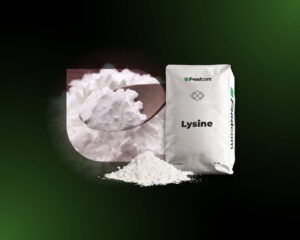- In 2025, the amino acid market entered a phase of maturity, with growth driven mainly by dietary supplements and functional foods.
- L-arginine, BCAAs, glycine, and L-glutamine strengthened their position as strategic ingredients in products supporting gut health, regeneration, and healthy aging.
- In 2026, the market will become more selective, increasingly rewarding quality, consistency, and suitability for product applications.
The year 2025 confirmed that functional amino acids have become one of the key segments of the global food, supplement and nutraceutical ingredients market. Substances such as L-arginine, glycine, branched-chain amino acids (BCAAs) and L-glutamine have ceased to be associated exclusively with sports supplementation and are increasingly functioning as the foundation of products that support gut health, immunity, recovery, cardiovascular health and long-term fitness maintenance.
The growth of the amino acid market is directly linked to global health trends: ageing populations, increasing nutritional awareness, the growing popularity of preventive health care and a consumer shift towards functional and ‘clean label’ products. In this context, amino acids with documented physiological effects are gaining status as strategic raw materials for supplement brands and functional food manufacturers.
Global amino acid market in 2025
By 2025, the global amino acid market was estimated to be worth approximately USD 33-34 billion, at a sustained compound annual growth rate (CAGR) of around 8%. These dynamics confirm that the market is in a phase of stable, long-term growth, with short-term forecasts indicating that it could exceed USD 36-37 billion as early as 2026. In the long term, market analyses suggest further consistent growth – to USD 69-74 billion by 2034 – highlighting the strategic importance of amino acids in the global food and health system.
Market growth in 2025, however, was not evenly spread across all segments. Functional amino acids used in dietary supplements, functional foods and products that support gut health, recovery and immunity grew fastest. This segment grew faster than traditional feed and industrial applications, gradually shifting the centre of gravity of the market towards higher value-added products. It was in these areas that demand for L-arginine, L-glutamine, BCAAs and glycine was concentrated.
On the supply side, the amino acid market continues to be highly geographically concentrated. The Asia-Pacific region retains its dominant position as both a major production base and one of the fastest-growing consumer markets in 2025. This is due to cost advantages, developed fermentation technologies and economies of scale. At the same time, Europe and North America act as key high-value-added end markets, especially in the premium dietary supplement segment.
In 2025, the shift of supplement brands and importers towards suppliers offering quality stability and full supply chain transparency was clearly visible. Factors such as repeatability of parameters, microbiological purity, completeness of quality documentation and the ability to ensure continuity of supply in a volatile cost environment were increasingly important.
The profile of the end consumer has also changed. An increasing proportion of the demand for amino acids came from people who care about health holistically, rather than exclusively from professional athletes. Amino acids began to be seen as part of a daily health routine to support recovery, sleep quality, immunity and the maintenance of muscle mass as we age. This shift in perception has broadened the consumer base and reduced the seasonality of demand.
Analysis of key amino acids
The following analysis focuses on the amino acids that play a key role in the dietary supplements and functional foods segment in 2025, combining growing clinical and health importance with clear market growth potential.
L-Arginine
By 2025, the global L-arginine market was valued at around US$530-685 million, with a projected compound annual growth rate (CAGR) of 8-9%, making it one of the more rapidly growing functional amino acids. Demand for L-arginine is primarily driven by the dietary supplement sector to support cardiovascular health, physical performance and recovery.
A key determinant of interest in this amino acid remains its role as a precursor to nitric oxide (NO), which influences vasodilation, improved blood flow and the efficiency of oxygen and nutrient transport. In 2025, L-arginine has been used extensively in both pre-workout formulas and in products aimed at consumers seeking long-term support for metabolic and circulatory function.
The importance of L-arginine in the healthy aging segment has clearly increased. The ageing of populations in Europe and North America has encouraged the development of supplements to support physical fitness, vascular elasticity and overall performance in middle-aged and older people. In response to these needs, manufacturers increasingly incorporated arginine into complex cardio-metabolic formulas, combining it with citrulline, magnesium, potassium and B vitamins.
BCAAs – leucine, isoleucine, valine
The branched-chain amino acid (BCAA) market is expected to reach approximately US$1.7-1.9 billion by 2025, maintaining a steady growth rate of 5-6% CAGR. Despite the maturity of the segment, BCAAs remain one of the pillars of the global dietary supplement market, especially in the areas of sports, fitness and muscle recovery.
In 2025, a change in the way BCAAs are positioned became increasingly apparent. These amino acids were no longer seen solely as a product for athletes, but increasingly functioned as part of a strategy for maintaining muscle mass and fitness over the long term. Leucine gained particular importance, being recognised as a key regulator of muscle protein synthesis (MPS), which opened up the BCAA segment for applications in senior nutrition, rehabilitation and recovery periods.
In parallel, branched-chain amino acids play an important role in animal nutrition, although in this segment they function as separate feed raw materials rather than as a common BCAA complex. Of particular importance are isoleucine and valine, widely used in poultry and pig diets for precise protein balancing and improved feed efficiency. In 2025, their use in feed has been further enhanced by the growing interest in low-protein diets to reduce nitrogen emissions and improve the sustainability of animal production.
However, the BCAA feed segment remains a volume market with high price competition and lower margins, markedly different from the dietary supplement market, where BCAAs retain a much higher unit value and strong branding potential.
Glycine
Glycine has cemented its position as an amino acid of growing strategic importance in the beauty-from-within, wellness and sleep support and stress reduction supplements segments in 2025. Although the glycine market is not reported as a separate value category, its consumption is growing in parallel with the dynamic growth of the collagen market and anti-aging and wellness products.
As one of the basic components of collagen, glycine plays a key role in products that improve the condition of skin, hair and nails, as well as supporting tissue regeneration. In 2025, there has also been growing interest in glycine in the context of sleep quality, relaxation and metabolic balance, which has significantly broadened the scope of its applications beyond the strictly cosmetic segment.
In parallel, glycine is used in animal nutrition, primarily in poultry feed, where it supports nitrogen metabolism and the efficiency of dietary protein utilisation. By 2025, glycine was growing in importance as an ingredient in protein-reduced feed diets, which is part of the broader trend of sustainable agriculture and optimised nutrition. From a market structure perspective, however, the feed segment remains a volume area, while the highest added value of glycine is generated in dietary supplements and wellness products with high quality requirements.
L-Glutamine
L-glutamine remains one of the most widely used functional amino acids in sports, clinical supplements and wellness products. In 2025, its importance has grown particularly strongly in the context of gut health (gut health) and immune support, which has translated into a steady increase in demand in the functional supplement segment.
Glutamine is a key source of energy for intestinal cells and is therefore widely used in products supporting intestinal barrier integrity, body regeneration and adaptation to physical and metabolic stress. The rapid growth of the market for supplements supporting intestinal health, valued at approximately USD 19 billion in 2025, has significantly strengthened the structural demand for L-glutamine.
In 2025, L-glutamine was also an important ingredient in recovery supplements for athletes, where its role in reducing muscle catabolism and accelerating recovery remains well established. Projections for the next few years indicate that glutamine will maintain its strong position as a functional amino acid with broad health applications, particularly in the premium and clinical segments.
Forecasts for 2026 – strategic outlook

In 2026, the amino acid market is increasingly clearly ceasing to be a market of volume growth and becoming a market of quality selection. After years of rapid expansion of supplements, many manufacturers are reducing the number of products and focusing on fewer key formulations, which directly increases the demands on individual amino acids. For customers, it is becoming increasingly important not whether an amino acid meets the specification on paper, but whether it behaves reproducibly over time, in a specific application and format, especially in RTD and multicomponent formulations. In practice, this means that the market advantage is being gained by suppliers able to maintain batch-to-batch parameter stability and actively support the application of the raw material, while companies competing purely on price are gradually being pushed into pure volume segments. This process is not a short-term trend, but a natural stage of market maturation after a period of oversupply and intense marketing competition.”
In 2026, the strongest growth momentum will remain in the segment of functional amino acids used in dietary supplements, functional foods and wellness products. Of particular importance will be solutions addressing the needs of healthy aging, muscle mass maintenance, regeneration and gut health. In this context, amino acids such as BCAAs, L-arginine and L-glutamine will increasingly be seen as part of everyday preventative health care, rather than exclusively sport supplementation.
The sports segment will remain an important pillar of the market, but its development in 2026 will be more selective and based on product innovation. The rise of RTD formats, combination formulas and personalisation of supplementation will keep demand for BCAAs stable, while broadening the audience to include consumers outside the classic fitness market.
In parallel, demand for amino acids supporting gut health and immunity will remain high in 2026, supporting further growth of L-glutamine in functional and clinical products. This trend is structural and is supported by growing consumer awareness and the further development of the gut health market.
From a geographical perspective, the market will remain strongly diversified in 2026. Asia and the Pacific will retain a dominant manufacturing position, while Europe and North America will continue to focus on higher value-added products. It is in these markets that quality standards, transparency in the supply chain and the ability of suppliers to collaborate over the long term will become increasingly important.
Strategically, 2026 will be a period of further maturation of the amino acid market. Competitive advantage will be gained by those who can combine stability of supply with high quality, product flexibility and an understanding of changing consumer needs. The market will increasingly place a premium on value, trust and function, rather than just price, encouraging further premiumisation of functional amino acids.
Global Reports from Foodcom S.A.
Curious about what’s next for amino acids? Discover the latest trends and insights that will shape 2026. Visit our blog as we regularly update our global reports. Stay up to date with Foodcom S.A.
![Overview of the amino acid market in 2026 [Global Report] Overview of the amino acid market in 2026 [Global Report]](https://foodcom.pl/wp-content/uploads/2025/12/global-report-aminokwasy-min.png)







